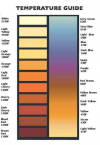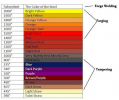- Joined
- Sep 21, 2021
- Messages
- 52
I just dropped my new fruit bat bushcraft knife. It was supposed to be done by Sunday, but I guess I can scrap that now.
Both are from the same bar of 80crv2. The first one, which turned out perfect was from a different bar. Not sure if it's the steel or me.
2 blades heat treated how I normally heat treat them have snapped. Normalized 3 times, heat treated right at magnetic, and tempered 3 times. Both had the same dark spot on the spine. This has put me behind and out of a little money. Can someone explain?
Both are from the same bar of 80crv2. The first one, which turned out perfect was from a different bar. Not sure if it's the steel or me.
2 blades heat treated how I normally heat treat them have snapped. Normalized 3 times, heat treated right at magnetic, and tempered 3 times. Both had the same dark spot on the spine. This has put me behind and out of a little money. Can someone explain?


